|
|
|
|
The figures in this report use shaded vertical bars to indicate periods of recession. Those bars extend from the peak to the trough of the recession. Numbers in the text and tables may not add up to totals because of rounding. |
This report provides material that supplements the Congressional Budget Office's (CBO's) The Economic and Budget Outlook: An Update (July 1, 1999). In accordance with CBO's mandate to provide objective and impartial analysis, this document contains no recommendations.
Ben Page of CBO's Macroeconomic Analysis Division prepared the memorandum under the direction of Robert Dennis and Douglas Hamilton. David Arnold and Ezra Finkin provided research assistance.
Sherry Snyder edited the report, and Leah Mazade proofread it. Dorothy
Kornegay and Verlinda Lewis Harris assisted in the production of the report.
Kathryn Quattrone prepared the final version for publication, and Laurie
Brown prepared the electronic versions for CBO's World Wide Web site (www.cbo.gov).
Dan L. Crippen
Director
December 14, 1999
THE METHODOLOGY FOR THE LONG-TERM BUDGET PROJECTIONS
SCENARIOS EMPLOYING VARIOUS ASSUMPTIONS ABOUT BUDGET SURPLUSES
APPENDIX: CHANGES IN THE
LONG-TERM PROJECTIONS SINCE JANUARY 1999
| TABLES | |
| 1. | Projections of Federal Receipts and Expenditures Under CBO's "Maintain Total Surpluses" Scenario, Calendar Years 1998-2070 |
| 2. | The Fiscal Gap Under Various Scenarios |
| 3. | Projections of Federal Receipts and Expenditures Under CBO's "No Asset Buildup" Scenario, Calendar Years 1998-2070 |
| 4. | Projections of Federal Receipts and Expenditures Under CBO's "Maintain Off-Budget Surpluses" Scenario, Calendar Years 1998-2070 |
| 5. | Projections of Federal Receipts and Expenditures Under CBO's "No Surpluses" Scenario, Calendar Years 1998-2070 |
| FIGURES | |
| 1. | Social Security, Medicare, and Medicaid Spending |
| 2. | Social Security, Medicare, and Medicaid Spending as a Percentage of Noninterest Federal Expenditures |
| 3. | Federal Debt Held by the Public Under Different Assumptions About Budget Surpluses |
| 4. | Projections of Federal Debt Held by the Public Under Different Assumptions About Federal Health Spending per Enrollee |
| 5. | Total Federal Receipts |
| 6. | Projections of Federal Debt Held by the Public Under Different Assumptions About Tax Receipts |
| 7. | Projections of Federal Debt Held by the Public Under Different Assumptions About Total Factor Productivity |
| 8. | Projections of Federal Debt Held by the Public Under Different Assumptions About Population |
| 9. | Discretionary Spending |
| 10. | Projections of Federal Debt Held by the Public Under Different Assumptions About Discretionary Spending |
| 11. | Projections of Federal Debt Held by the Public Under Different Assumptions About the Interest Rate on Government Debt |
The federal budget is currently in surplus, and the fiscal outlook for the next decade is rosy. However, long-term budgetary pressures from demographic changes and rising health care costs remain. The Congressional Budget Office (CBO) projects that in the absence of policy changes, those pressures will probably drive the budget back into deficit and eventually lead to serious fiscal problems. The timing of those developments depends largely on policymakers' response to fiscal conditions, such as rising surpluses and falling debt, and on unpredictable economic and demographic variables, such as productivity and mortality rates.
Federal health and retirement programs will account for most of the
pressure on the budget. Under a variety of assumptions, CBO projects that
outlays for Social Security, Medicare, and Medicaid as a share of gross
domestic product (GDP) will almost double by 2030 (see Figure 1). That
increase will have a major impact on the federal budget: spending for those
three programs will climb from about 45 percent of federal outlays (excluding
interest costs) in 1998 to about 65 percent in 2030 (see Figure 2). The
increased spending stems from three main sources: the aging of the large
baby-boom generation, increases in average life span, and growth in costs
per enrollee in federal health programs that exceeds growth of the average
wage.
|
Figure 1. Social Security, Medicare, and Medicaid Spending |
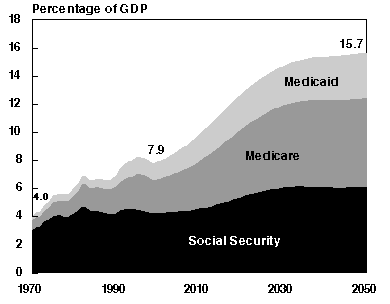 |
|
|
| SOURCE: Congressional Budget Office. |
| NOTES: Based on measures from the national income and product accounts. |
| Shares after 1998 are based on the assumption that the surpluses in CBO's 10-year baseline are maintained (the "maintain total surpluses" scenario). Most other assumptions yield similar percentages of GDP. |
|
|
|
Figure 2. Social Security, Medicare, and Medicaid Spending as a Percentage of Noninterest Federal Expenditures |
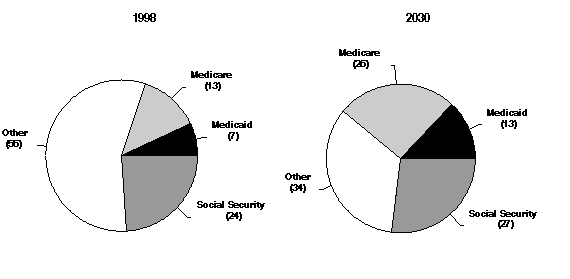 |
|
|
| SOURCE: Congressional Budget Office. |
| NOTE: Based on measures from the national income and product accounts. |
| a. Shares in 2030 are based on the assumption that the surpluses in CBO's 10-year baseline are maintained (the "maintain total surpluses" scenario). Most other assumptions yield similar shares. |
|
|
Under most assumptions, revenues will not be sufficient to finance the increased spending for federal health and retirement programs. At some point, the share of GDP devoted to government outlays must be lowered, or revenue raised, to avoid unsustainable increases in federal debt. Policy options range from incremental changes in existing entitlements, other spending programs, or taxes, to fundamental entitlement reforms such as partially or wholly privatizing Social Security. In the end, the size of the economy will determine the total resources available to future workers and retirees. Actions that promote a larger economy can ease the burden of financing the health and retirement needs of a growing elderly population. In addition, as the economy expands, government spending is likely to represent a smaller share of GDP. However, the level of some components of spending, such as Social Security benefits and wages paid to government workers, will increase.
The projections in this report are based on the budget outlook as of
July 1, 1999. CBO will present updated 10-year baseline projections of
the budget and the economy in January 2000, and those projections could
change the long-term outlook.
The Methodology for the Long-Term Budget Projections
CBO's long-term projections are based on a variety of assumptions about fiscal policy and economic and demographic variables. Instead of developing a "base scenario," as CBO has done in the past, this analysis presents 12 different scenarios to emphasize the extreme uncertainty of the projections and the difficulty of determining the set of assumptions that best represents the likely future path of the budget.
Through 2009, the long-term projections are based on the 10-year baseline projections that CBO issued in July 1999, which assume current laws and policies.(1) (The changes in the baseline since January 1999 are discussed in the appendix.) In most scenarios, the first 10 years exactly match the 10-year baseline projections. In some, however, the 10-year baseline is modified by assuming that tax cuts or increased spending dissipate some or all of the projected surpluses.
After 2009, CBO uses current-law assumptions to project Social Security and Medicare. The long-term projections of outlays for Social Security are based on forecasts by the trustees of the Social Security trust funds, adjusted for CBO's economic assumptions; the Medicare projections are based on projected health care costs per enrollee and the number and age of enrollees.(2) In most scenarios, CBO has followed the trustees of the Medicare trust funds in assuming that the growth in costs per enrollee will slow over the next 25 years to about the growth of the average wage. One scenario assumes that the slowdown is delayed by 10 years.
CBO extends most other categories of spending and revenue beyond 2009 using simple rules based on historical patterns rather than current law. The long-term projections assume that tax receipts remain constant as a share of GDP after the first 10 years. Most of the scenarios set that constant share at its level in 2009; one scenario assumes a smaller share on the basis of historical experience. Discretionary spending remains at its 2009 share of net national product (GDP minus depreciation); one scenario, however, assumes that real (inflation-adjusted) spending is constant. All scenarios assume that spending on other nonretirement government transfer programs, such as unemployment insurance, grows with demographic demands, inflation, and labor productivity.(3)
The projections assume that economic growth depends on hours of labor, the size of the capital stock, and total factor productivity (TFP). Hours of labor depend on the size and age composition of the population. Most scenarios use the intermediate population assumptions of the Social Security trustees; others use their low-cost or high-cost population assumptions. (Mortality and birth rates are higher in the low-cost and lower in the high-cost population assumptions.) The private capital stock grows as net investment is added; budget surpluses increase national saving and investment. TFP determines the amount of output that can be produced with given quantities of labor and capital; it can be thought of as a measure of technology. In most scenarios, TFP is assumed to grow at its postwar average rate, adjusted for changes in the measurement of prices; in some, TFP growth is half a percentage point higher or lower.
Another economic variable that affects the budget is the interest rate on government debt. Most scenarios assume that interest rates move in tandem with the return on capital (that is, the return earned on real investment, such as plant and equipment, after corporate taxes); one scenario assumes that the average interest rate on government debt is equal to the growth rate of the economy.
The projections use the budget categories of the national income and product accounts (NIPAs) in order to maintain consistency with the economic variables. NIPA measures of spending and revenue differ from those in the more commonly cited unified, or total, budget because of accounting and timing differences.(4)
For each scenario, CBO estimates the long-term imbalance in the budget.
That imbalance is summarized by a single number: the fiscal gap. The fiscal
gap is the size, expressed as a percentage of GDP, of the immediate and
permanent increase in revenue or decrease in spending that would be necessary
to keep debt at or below its 1998 share of GDP through 2073.(5)
Scenarios Employing Various Assumptions About Budget Surpluses
The level of the budget surpluses over the next 10 years has an important
effect on the long-term projections. This report therefore presents scenarios
with several different assumptions about how large those surpluses will
be.(6) Changes to either
tax or spending policies could alter future surpluses. In two of the scenarios
below--the "maintain off-budget surpluses" scenario and the "no surpluses"
scenario--projected surpluses are altered through equal changes in taxes
and spending. In one--the "no asset buildup" scenario--only taxes are changed.
Because the long-term budget model does not incorporate any incentive effects
of taxes on labor supply or private saving, or productivity effects of
government investment on private output, it projects similar paths for
debt and the deficit whether the change occurs in taxes or spending.
Maintain Total Surpluses
One scenario assumes that current laws and policies will be maintained and that economic and budgetary variables will match those in CBO's 10-year baseline projections over the 1999-2009 period. That assumption implies that all of the projected surpluses materialize. Thereafter, spending and revenue evolve according to the long-term rules described above.
Under this scenario, the federal budget would post large surpluses over
the next 20 years, and federal debt held by the public would be fully repaid
by 2011 (see Figure 3). After 2011, continued surpluses would enable the
government to accumulate a large stock of assets, reaching 17 percent of
GDP in the early 2020s.(7)
|
Figure 3. Federal Debt Held by the Public Under Different Assumptions About Budget Surpluses |
 |
|
|
| SOURCE: Congressional Budget Office. |
|
|
Those gains, however, would not be permanent. Expenditures on old-age
and health programs would rise, and by 2028 the budget would fall into
a deficit, which would be financed by selling off assets (see Table 1).
By 2037, all assets would have been sold, and the government would begin
to issue debt again. Debt would expand quickly thereafter, reaching 100
percent of GDP by 2062. The fiscal gap under these assumptions would be
0.5 percent of GDP (see Table 2).
|
Table 1. Projections of Federal Receipts and Expenditures Under CBO's "Maintain Total Surpluses" Scenario, Calendar Years 1998-2070 (As a percentage of GDP) |
|||||||||||
| 1998 | 2010 | 2020 | 2030 | 2040 | 2050 | 2060 | 2070 | ||||
|
|
|||||||||||
| NIPA Receipts | 21.7 | 21.1 | 21.1 | 21.1 | 21.1 | 21.1 | 21.1 | 21.1 | |||
| NIPA Expenditures | |||||||||||
| Federal consumption expenditures | 5.4 | 4.0 | 3.9 | 3.9 | 3.9 | 3.9 | 3.9 | 3.7 | |||
| Federal transfers, grants, and subsidies | |||||||||||
| Social Security | 4.3 | 4.6 | 5.4 | 6.1 | 6.1 | 6.1 | 6.5 | 7.3 | |||
| Medicare | 2.4 | 3.4 | 4.8 | 5.8 | 6.2 | 6.3 | 6.5 | 6.7 | |||
| Medicaid | 1.2 | 1.9 | 2.5 | 2.8 | 3.1 | 3.2 | 3.3 | 3.4 | |||
| Other | 4.8 | 4.1 | 4.0 | 3.8 | 3.7 | 3.6 | 3.6 | 3.5 | |||
| Net interest | 2.7 | 0.2 | -1.0 | -0.7 | 0.3 | 2.3 | 6.4 | 20.4 | |||
| Total | 20.8 | 18.1 | 19.6 | 21.7 | 23.3 | 25.5 | 30.2 | 44.9 | |||
| NIPA Deficit (-) or Surplus | 0.9 | 3.0 | 1.5 | -0.6 | -2.2 | -4.4 | -9.1 | -23.8 | |||
| Memorandum: | |||||||||||
| Primary (Noninterest) Deficit (-) or Surplus | 3.5 | 3.2 | 0.5 | -1.3 | -1.8 | -2.1 | -2.7 | -3.4 | |||
| Debt Held by the Publica | 44.1 | 1.5 | -16.7 | -11.3 | 8.0 | 35.9 | 85.5 | 206.8 | |||
| Gross Domestic Product (Trillions of dollars) | 8.5 | 14.3 | 21.7 | 32.5 | 48.8 | 72.1 | 103.8 | 138.7 | |||
|
|
|||||||||||
| SOURCE: Congressional Budget Office. | |||||||||||
| NOTE: NIPA = national income and product accounts. | |||||||||||
| a. The government holds financial assets when debt held by the public is negative. | |||||||||||
|
|
|||||||||||
|
Table 2. The Fiscal Gap Under Various Scenarios |
|||
| Assumption | Fiscal Gap (Percentage of GDP) |
||
|
|
|||
| Budget Surpluses | |||
| Maintain total surpluses | 0.5 | ||
| No asset buildup | 0.7 | ||
| Maintain off-budget surpluses | 1.2 | ||
| No surpluses | 2.1 | ||
| Health Costs' Slowdown in Growth Is Delayed 10 Years | 2.8 | ||
| Tax Receipts Fall to 19.5 Percent of GDP After 2009 | 1.6 | ||
| Productivity | |||
| Total factor productivity grows 0.5 percentage points faster | -0.5 | ||
| Total factor productivity grows 0.5 percentage points slower | 1.6 | ||
| Population | |||
| Social Security trustees' high-cost population assumptions | 1.2 | ||
| Social Security trustees' low-cost population assumptions | 0 | ||
| Discretionary Spending Grows with Inflation After 2009 | -0.7 | ||
| Interest Rate Equals Economic Growth After 2009 | 0.6 | ||
|
|
|||
| SOURCE: Congressional Budget Office. | |||
| NOTE: The fiscal gap is the size of the permanent tax increase or spending cut that would be needed to keep federal debt at or below its 1998 share of GDP through 2073. | |||
|
|
|||
No Asset Buildup
Assuming that the government will build up a large stock of assets once
federal debt is paid off, as in the above scenario, may be unrealistic.
Some analysts argue that having the government invest in private assets,
such as corporate equity or debt, would be inappropriate. Furthermore,
supporting such investment could be particularly difficult if fiscal problems
appeared to be decades away. For those reasons, policymakers might temporarily
cut taxes or raise spending to prevent the government from acquiring assets
after 2011.(8) With no
buildup of assets, budgetary pressures would assert themselves sooner (see
Table 3 and Figure 3). In addition, the fiscal gap would rise to 0.7 percent
of GDP.
|
Table 3. Projections of Federal Receipts and Expenditures Under CBO's "No Asset Buildup" Scenario, Calendar Years 1998-2070 (As a percentage of GDP) |
||||||||||||
| 1998 | 2010 | 2015 | 2020 | 2030 | 2040 | 2050 | 2060 | 2070 | ||||
|
|
||||||||||||
| NIPA Receipts | 21.7 | 21.1 | 19.4 | 20.8 | 21.1 | 21.1 | 21.1 | 21.1 | n.c. | |||
| NIPA Expenditures | ||||||||||||
| Federal consumption expenditures | 5.4 | 4.0 | 3.9 | 3.9 | 3.9 | 3.9 | 3.9 | 3.8 | n.c. | |||
| Federal transfers, grants, and subsidies | ||||||||||||
| Social Security | 4.3 | 4.6 | 5.0 | 5.5 | 6.1 | 6.1 | 6.2 | 6.9 | n.c. | |||
| Medicare | 2.4 | 3.4 | 4.1 | 4.8 | 5.8 | 6.2 | 6.3 | 6.5 | n.c. | |||
| Medicaid | 1.2 | 1.9 | 2.3 | 2.5 | 2.8 | 3.1 | 3.2 | 3.2 | n.c. | |||
| Other | 4.8 | 4.1 | 4.1 | 4.0 | 3.8 | 3.7 | 3.6 | 3.6 | n.c. | |||
| Net interest | 2.7 | 0.2 | -0.1 | -0.1 | 0.4 | 2.0 | 5.2 | 13.9 | n.c. | |||
| Total | 20.8 | 18.1 | 19.2 | 20.5 | 22.9 | 25.0 | 28.4 | 37.8 | n.c. | |||
| NIPA Deficit (-) or Surplus | 0.9 | 3.0 | 0.2 | 0.3 | -1.7 | -3.9 | -7.3 | -16.7 | n.c. | |||
| Memorandum: | ||||||||||||
| Primary (Noninterest) Deficit (-) or Surplus | 3.5 | 3.2 | 0.1 | 0.2 | -1.4 | -1.9 | -2.1 | -2.8 | n.c. | |||
| Debt Held by the Public | 44.1 | 1.5 | a | a | 8.8 | 33.4 | 73.4 | 158.8 | n.c. | |||
| Gross Domestic Product (Trillions of dollars) | 8.5 | 14.3 | 17.5 | 21.5 | 32.1 | 47.8 | 69.7 | 96.5 | n.c. | |||
|
|
||||||||||||
| SOURCE: Congressional Budget Office. | ||||||||||||
| NOTES: This projection assumes that rising deficits affect interest rates and economic growth. | ||||||||||||
| NIPA = national income and product accounts; n.c. = not computable (debt would exceed levels that the economy could reasonably support). | ||||||||||||
| a. Less than 0.05 percent. | ||||||||||||
|
|
||||||||||||
Maintain Off-Budget Surpluses
A number of recent proposals from the Congress and the President have sought to protect the Social Security surplus (which accounts for most of the so-called off-budget surplus) but use the remainder of the overall surpluses for other priorities, such as reducing taxes or increasing spending. This scenario, as well as the following one, assumes that the changes to taxes and spending are permanent: revenue and discretionary spending as a share of output are altered in 2009, and the new shares are maintained over the remaining 65 years.
Spending the on-budget surplus on tax cuts or spending increases over
the next 10 years would further increase long-term pressures. Debt would
never fall to zero and would rise to unsustainable levels much sooner (see
Table 4 and Figure 3). The fiscal gap would rise to 1.2 percent.
|
Table 4. Projections of Federal Receipts and Expenditures Under CBO's "Maintain Off-Budget Surpluses" Scenario, Calendar Years 1998-2070 (As a percentage of GDP) |
|||||||||||
| 1998 | 2010 | 2020 | 2030 | 2040 | 2050 | 2060 | 2070 | ||||
|
|
|||||||||||
| NIPA Receipts | 21.7 | 20.7 | 20.7 | 20.7 | 20.7 | 20.7 | n.c. | n.c. | |||
| NIPA Expenditures | |||||||||||
| Federal consumption expenditures | 5.4 | 4.3 | 4.2 | 4.2 | 4.1 | 4.1 | n.c. | n.c. | |||
| Federal transfers, grants, and subsidies | |||||||||||
| Social Security | 4.3 | 4.6 | 5.5 | 6.2 | 6.3 | 6.6 | n.c. | n.c. | |||
| Medicare | 2.4 | 3.4 | 4.8 | 5.9 | 6.2 | 6.3 | n.c. | n.c. | |||
| Medicaid | 1.2 | 1.9 | 2.5 | 2.8 | 3.1 | 3.2 | n.c. | n.c. | |||
| Other | 4.8 | 4.2 | 4.1 | 4.0 | 3.8 | 3.7 | n.c. | n.c. | |||
| Net interest | 2.7 | 0.7 | 0.2 | 1.3 | 4.3 | 11.7 | n.c. | n.c. | |||
| Total | 20.8 | 19.0 | 21.3 | 24.3 | 27.9 | 35.6 | n.c. | n.c. | |||
| NIPA Deficit (-) or Surplus | 0.9 | 1.7 | -0.5 | -3.6 | -7.2 | -14.9 | n.c. | n.c. | |||
| Memorandum: | |||||||||||
| Primary (Noninterest) Deficit (-) or Surplus | 3.5 | 2.3 | -0.4 | -2.3 | -2.8 | -3.2 | n.c. | n.c. | |||
| Debt Held by the Public | 44.1 | 10.1 | 4.4 | 24.6 | 66.5 | 145.0 | n.c. | n.c. | |||
| Gross Domestic Product (Trillions of dollars) | 8.5 | 14.2 | 21.4 | 31.8 | 46.6 | 65.4 | n.c. | n.c. | |||
|
|
|||||||||||
| SOURCE: Congressional Budget Office. | |||||||||||
| NOTES: This projection assumes that rising deficits affect interest rates and economic growth. | |||||||||||
| NIPA = national income and product accounts; n.c. = not computable (debt would exceed levels that the economy could reasonably support). | |||||||||||
|
|
|||||||||||
No Surpluses
In the past, balancing the total budget has been a major goal of both
the Congress and the President. However, the combination of a strong economy,
unexpectedly high tax receipts, and some changes in tax and spending policies
have pushed the budget into surplus and allowed the federal government
to exceed that goal. Policymakers may, however, return to the goal of balancing
the total budget. That would imply spending the entire surplus projected
over the next 10 years on tax cuts or spending increases. With no surpluses,
fiscal problems would develop considerably sooner (see Figure 3 and Table
5). The fiscal gap would be 2.1 percent.
|
Table 5. Projections of Federal Receipts and Expenditures Under CBO's "No Surpluses" Scenario, Calendar Years 1998-2070 (As a percentage of GDP) |
|||||||||||
| 1998 | 2010 | 2020 | 2030 | 2040 | 2050 | 2060 | 2070 | ||||
|
|
|||||||||||
| NIPA Receipts | 21.7 | 20.3 | 20.3 | 20.3 | 20.3 | n.c. | n.c. | n.c. | |||
| NIPA Expenditures | |||||||||||
| Federal consumption expenditures | 5.4 | 4.6 | 4.5 | 4.5 | 4.4 | n.c. | n.c. | n.c. | |||
| Federal transfers, grants, and subsidies | |||||||||||
| Social Security | 4.3 | 4.6 | 5.5 | 6.3 | 6.7 | n.c. | n.c. | n.c. | |||
| Medicare | 2.4 | 3.4 | 4.9 | 5.9 | 6.2 | n.c. | n.c. | n.c. | |||
| Medicaid | 1.2 | 1.9 | 2.6 | 2.9 | 3.1 | n.c. | n.c. | n.c. | |||
| Other | 4.8 | 4.4 | 4.2 | 4.1 | 3.9 | n.c. | n.c. | n.c. | |||
| Net interest | 2.7 | 1.6 | 1.9 | 4.8 | 13.3 | n.c. | n.c. | n.c. | |||
| Total | 20.8 | 20.5 | 23.6 | 28.4 | 37.6 | n.c. | n.c. | n.c. | |||
| NIPA Deficit (-) or Surplus | 0.9 | -0.2 | -3.3 | -8.1 | -17.3 | n.c. | n.c. | n.c. | |||
| Memorandum: | |||||||||||
| Primary (Noninterest) Deficit (-) or Surplus | 3.5 | 1.4 | -1.4 | -3.4 | -4.0 | n.c. | n.c. | n.c. | |||
| Debt Held by the Public | 44.1 | 26.2 | 34.4 | 77.5 | 168.6 | n.c. | n.c. | n.c. | |||
| Gross Domestic Product (Trillions of dollars) | 8.5 | 14.1 | 21.0 | 30.6 | 42.7 | n.c. | n.c. | n.c. | |||
|
|
|||||||||||
| SOURCE: Congressional Budget Office. | |||||||||||
| NOTES: This projection assumes that rising deficits affect interest rates and economic growth. | |||||||||||
| NIPA = national income and product accounts; n.c. = not computable (debt would exceed levels that the economy could reasonably support). | |||||||||||
|
|
|||||||||||
Alternative Assumptions About Health Costs, Tax Receipts, Productivity, Population, Discretionary Spending, and Interest Rates
In addition to the various scenarios for using the surplus, CBO has developed scenarios with alternative long-term economic and policy assumptions. To better demonstrate the effects of each long-term assumption, those scenarios assume current law over the first 10 years, as in the "maintain total surpluses" scenario.(9) Using a different assumption about the surplus could mask the effects of some long-term assumptions. For example, if productivity growth was higher, the government would run much larger surpluses through 2009. However, if one assumed that those surpluses would be used for tax cuts or spending increases, the long-run effect of higher productivity on the budget would be much smaller.
Health Costs
A major source of uncertainty for the path of Medicare and Medicaid spending is the future growth rate of costs per enrollee. Spending per enrollee has risen faster than the average wage in most years since the programs began, and CBO expects that trend to continue over the next 10 years. However, this analysis assumes that growth in costs per enrollee will gradually slow between 2010 and 2023 to that of the average wage. The trustees of the Medicare trust funds make similar assumptions.
CBO chose to project a deceleration in cost growth because if health
care costs outpaced economic growth forever, the medical sector would eventually
take over the entire economy. However, the timing of any possible changes
in cost growth is highly uncertain. If the slowdown in the growth of spending
per enrollee was delayed for 10 years--so that it took place between 2020
and 2033--the ratio of debt to GDP would rise much faster (see Figure 4).
In addition, the fiscal gap would climb to 2.8 percent of GDP (see Table
2).
|
Figure 4. Projections of Federal Debt Held by the Public Under Different Assumptions About Federal Health Spending per Enrollee |
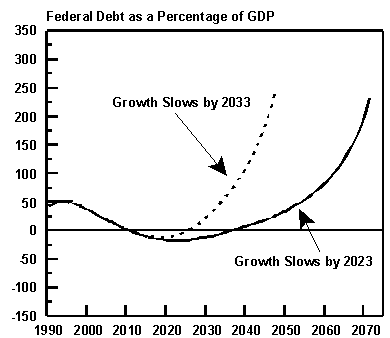 |
|
|
| SOURCE: Congressional Budget Office. |
|
|
Tax Receipts
Tax receipts have a significant effect on the long-term outlook and are difficult to forecast even in the short run. For example, in January 1998, CBO forecast that federal NIPA receipts would reach $1,766 billion, or 20.9 percent of GDP, in fiscal year 1998. Actual receipts turned out to be $1,818 billion, or 21.6 percent of GDP.(10)
In the 10-year baseline projections, receipts as a share of GDP decline
slightly, to 21.1 percent by 2009. Most of the long-term projections assume
that that share remains at 21.1 percent from 2010 through 2073. However,
that share is higher than in any year during the postwar period except
1998. Thus, the assumption that NIPA receipts will remain at such a high
level for 75 years may be unrealistic. Receipts have increased sharply
as a percentage of GDP since 1994, but over the preceding decade, they
fluctuated in a narrow range around 19.5 percent (see Figure 5). If receipts
returned to that percentage after 2009, the long-term outlook would be
substantially worse (see Figure 6). The fiscal gap would rise to 1.6 percent.
|
Figure 5. Total Federal Receipts |
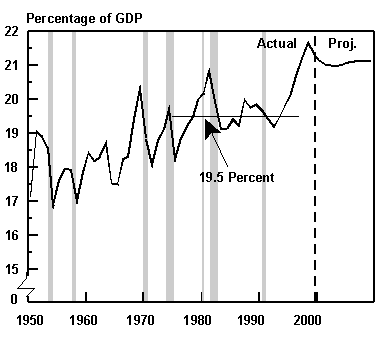 |
|
|
| SOURCE: Congressional Budget Office using data from the Department of Commerce, Bureau of Economic Analysis. |
| NOTES: From 1999 to 2009, receipts are based on CBO's projections published in The Economic and Budget Outlook: An Update (July 1, 1999). |
| Receipts are based on the national income and product accounts, not the unified budget. |
|
|
|
Figure 6. Projections of Federal Debt Held by the Public Under Different Assumptions About Tax Receipts |
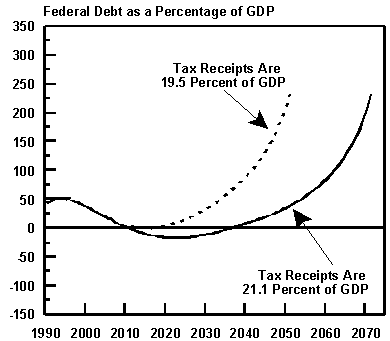 |
|
|
| SOURCE: Congressional Budget Office. |
|
|
Productivity
The growth rate of productivity directly affects GDP and wages and thus indirectly affects the budget. The model used for the long-term projections assumes that taxes grow with economic output. When productivity is higher, tax receipts grow faster relative to most categories of spending over the first 10 years, to interest on the debt over the entire projection period, and to Social Security outlays for an extended period. Increases in productivity raise revenue immediately but boost Social Security outlays only gradually as workers with higher lifetime earnings retire. (Social Security benefits are based on retirees' earnings histories.) Changes in productivity do not affect projections of most other spending programs relative to receipts after the first 10 years because the model assumes that spending for those programs will rise with economic output.
Most scenarios assume that total factor productivity grows in the long
run at 1.6 percent per year, phased in after the first 10 years, but TFP
growth could well be considerably faster or slower. If TFP growth was half
a percentage point faster, the long-term outlook would improve, shrinking
the fiscal gap to -0.5 percent of GDP; if growth was half a percentage
point slower, the outlook would be worse, raising the fiscal gap to 1.6
percent (see Figure 7). (A negative gap means that tax rates would have
to be lower, rather than higher, for the projected debt to equal its 1998
share of GDP--44 percent--in 2073.)
|
Figure 7. Projections of Federal Debt Held by the Public Under Different Assumptions About Total Factor Productivity |
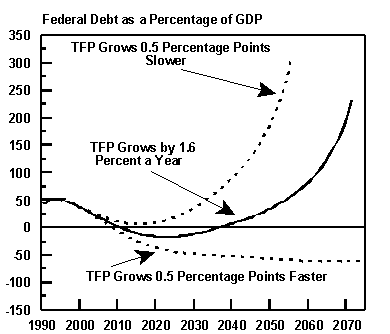 |
|
|
| SOURCE: Congressional Budget Office. |
| NOTE: TFP = total factor productivity. |
|
|
Population
The future path of the population is another key assumption in long-term
projections because the number of workers relative to elderly people has
a large effect on the budget. Most scenarios assume that the future population
will match the intermediate projection of the Social Security trustees.
Alternatively, the population could grow according to the trustees' high-cost
or low-cost projections. Under the high-cost population projections, which
imply relatively fewer workers and more elderly people, federal debt rises
sooner and faster; the low-cost population projections have the opposite
effect (see Figure 8). The high-cost population assumptions imply a fiscal
gap of 1.2 percent of GDP; the low-cost population assumptions eliminate
the gap.
|
Figure 8. Projections of Federal Debt Held by the Public Under Different Assumptions About Population |
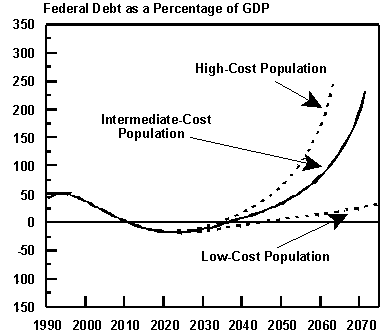 |
|
|
| SOURCE: Congressional Budget Office. |
|
|
Discretionary Spending
The Congress specifies discretionary spending in 13 annual appropriation bills. Those bills cover most spending for defense, foreign aid, science, space, transportation, environmental protection, and law enforcement, among other programs.
Discretionary spending has declined from 13.6 percent of GDP in fiscal
year 1968 to 6.9 percent in 1997. CBO's 10-year projections foresee a further
drop, to 5.0 percent of GDP, by 2009 (see Figure 9).
|
Figure 9. Discretionary Spending (By fiscal year) |
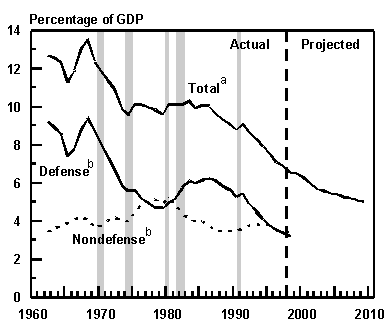 |
|
|
| SOURCE: Congressional Budget Office. |
| a. Includes unspecified reductions necessary to comply with the discretionary spending caps from 2000 through 2002. |
| b. Shown only through 1999 because its future path depends on unspecified reductions. |
|
|
Because such spending is subject to annual appropriations, it is difficult
to project on a long-term basis. Most of the scenarios assume that discretionary
spending stays constant as a share of net national product after 2009.
Alternatively, discretionary spending might grow only at the rate of inflation
and thus remain fixed in real terms. That assumption dramatically improves
the long-term outlook: federal debt would remain below its current share
of GDP over the entire 75-year projection period (see Figure 10). The fiscal
gap would drop to -0.7 percent of GDP.
|
Figure 10. Projections of Federal Debt Held by the Public Under Different Assumptions About Discretionary Spending |
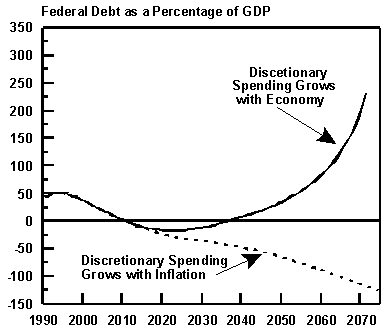 |
|
|
| SOURCE: Congressional Budget Office. |
|
|
Holding increases in discretionary spending to the rate of inflation may be difficult, however. That policy implies a steep decline in spending as a share of GDP over time, from 6.6 percent in 1998 to about 1 percent in 2070. Although discretionary spending as a share of output has fallen by more than half since 1968, most of that drop was attributable to a decrease in the share of output devoted to defense spending following the end of the Vietnam War and the Cold War. However, the share of defense spending will probably reach a stable, long-term peacetime level at some point, even without accounting for the possibility of future conflict. Nondefense discretionary spending as a share of output has been much more stable historically, suggesting that significant declines over the long term may be unlikely.
Interest Rates
The relationship between the interest rate on government debt and the growth rate of nominal output has a large effect on the projection. That relationship is important because when the interest rate is higher than the growth rate of output, debt will rise as a share of GDP unless the primary (or noninterest) surplus is large enough to offset interest costs.
In CBO's 10-year baseline, the interest rate on debt continues to exceed the growth rate of output, as it has for the past two decades. Most scenarios assume that that difference eventually expands as rising deficits crowd out investment in capital, leading to higher interest rates and lower economic growth.
However, many factors affect interest rates and economic growth rates,
and their relationship has varied in the past. From 1947 to 1981, for example,
the interest rate on federal debt was generally below the growth rate.
An alternative assumption sets the interest rate on federal debt equal
to the growth rate of the economy after 2009. In that case, debt as a share
of GDP would rise more slowly, although pressures on the budget would still
build eventually (see Figure 11). The fiscal gap would be 0.6 percent.
|
Figure 11. Projections of Federal Debt Held by the Public Under Different Assumptions About the Interest Rate on Government Debt |
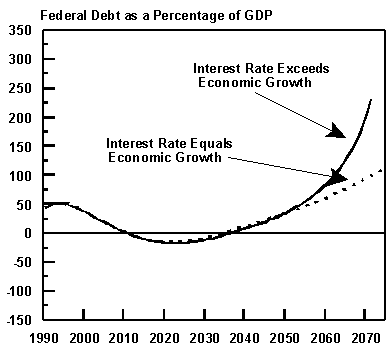 |
|
|
| SOURCE: Congressional Budget Office. |
|
|
The aging of the large baby-boom generation and the growth of health
care costs will put upward pressure on government expenditures in the next
century. To the extent that the budget remains in surplus over the near
term, reduced debt and lower interest costs will offset some portion of
that pressure. Saving all of the surpluses projected in CBO's 10-year baseline
could delay the onset of serious fiscal problems until the second half
of the next century. Changes to the tax system that reduced disincentives
to work and save, or unusually productive government investment, might
also help delay the onset of problems. Regardless of those actions, however,
the rising pressure on spending will probably have to be addressed through
changes in policy at some point.
1. See Congressional Budget Office, The Economic and Budget Outlook: An Update (July 1, 1999).
2. The long-term projections also follow the Social Security trustees in assuming that Social Security benefits will continue to be paid even if the trust fund is exhausted.
3. See Congressional Budget Office, An Economic Model for Long-Run Budget Simulations, CBO Memorandum (July 1997), for a detailed description of the methods that CBO uses for its long-term projections.
4. For a detailed description of the differences between NIPA and unified accounting, see Congressional Budget Office, The Federal Sector of the National Income and Product Accounts (July 1999).
5. The actual tax increase required would probably be higher than the estimated fiscal gap because the calculation of the gap does not assume that higher taxes would reduce labor supply or private saving. Estimating those effects would require specifying the exact changes in tax policy, but the model used for the long-term projections cannot simulate such detailed changes. For an example of estimates of the effects of tax changes on saving and labor supply, see Congressional Budget Office, Two Papers on Fundamental Tax Reform, CBO Memorandum (October 1997).
The Social Security trustees use the same 75-year horizon in calculating the actuarial balance in the Social Security system. That measure differs from the fiscal gap in that it applies only to the revenue and spending of the Social Security system. Therefore, it does not account for the positive effect of on-budget surpluses over the near term or for the negative effect of other fast-growing programs such as Medicare. In addition, the trustees' measure is stated as a share of taxable payroll rather than GDP.
6. Other assumptions used in this section include the following: taxes and discretionary spending maintain their 2009 shares of GDP through 2073; growth of costs per Medicare and Medicaid enrollee slows over the next 25 years to the growth in the average wage; productivity grows in the long run at its average rate over the postwar period, adjusted for changes in the measurement of prices; population matches the intermediate projections of the Social Security trustees; and interest rates move in tandem with the return on capital.
7. CBO's projections assume that the government would purchase relatively riskless assets that would pay the same average interest rate as government debt.
8. Note that under this scenario, the long-term assumption for taxes is temporarily suspended. However, once debt begins to accrue, taxes will equal the same share of GDP as in 2009.
9. Despite the assumption of current law, the surpluses in some alternative scenarios do not match those in CBO's 10-year baseline because of altered economic or demographic assumptions.
10. These figures are based on the NIPAs before the benchmark revisions of October 1999. The revisions reduced receipts as a share of GDP in both 1998 and 1999, but the share still rises significantly between the two years. Also note that Tables 1, 3, 4, and 5 show a share of 21.7 percent for 1998 because they reflect calendar rather than fiscal years.

